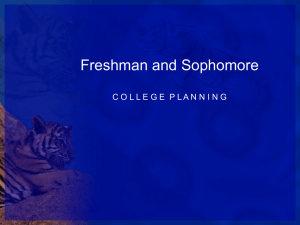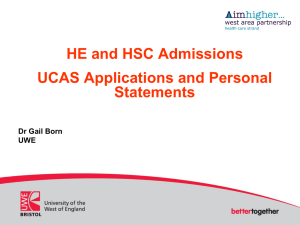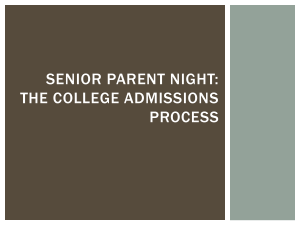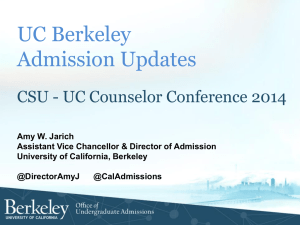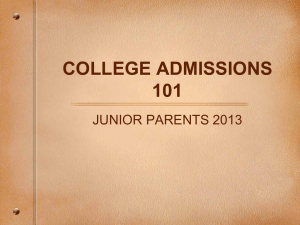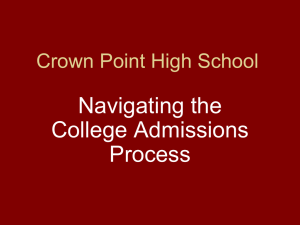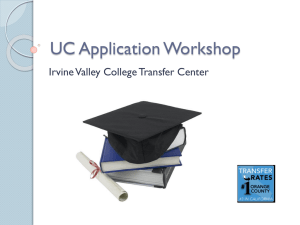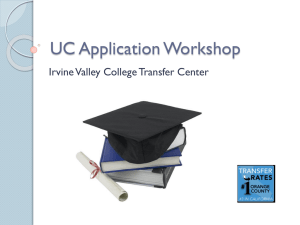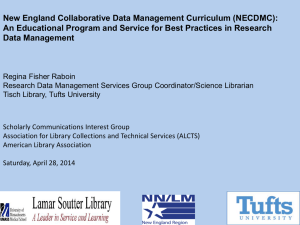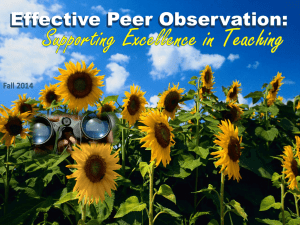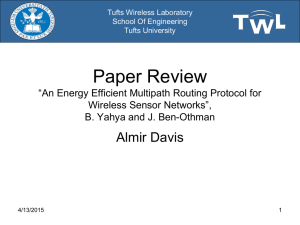Noncognitive Variables (Sedlacek, 2004)
advertisement
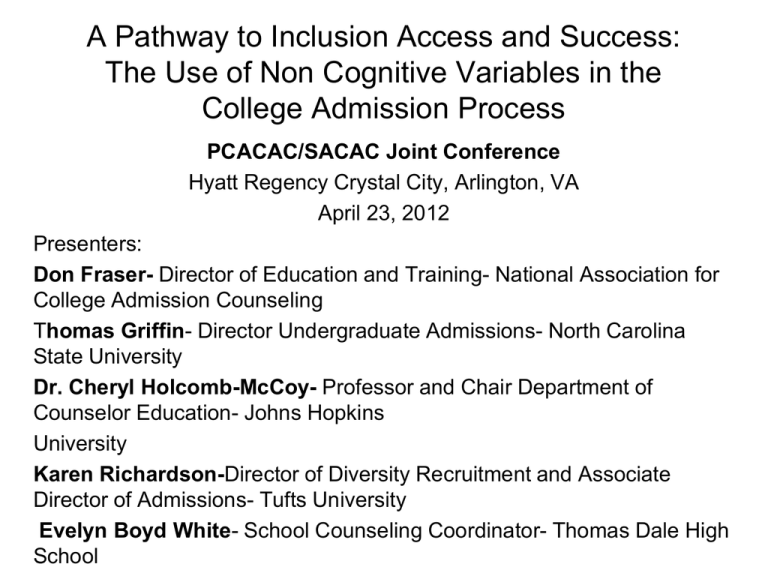
A Pathway to Inclusion Access and Success: The Use of Non Cognitive Variables in the College Admission Process PCACAC/SACAC Joint Conference Hyatt Regency Crystal City, Arlington, VA April 23, 2012 Presenters: Don Fraser- Director of Education and Training- National Association for College Admission Counseling Thomas Griffin- Director Undergraduate Admissions- North Carolina State University Dr. Cheryl Holcomb-McCoy- Professor and Chair Department of Counselor Education- Johns Hopkins University Karen Richardson-Director of Diversity Recruitment and Associate Director of Admissions- Tufts University Evelyn Boyd White- School Counseling Coordinator- Thomas Dale High School NACAC’s Interest in Non-Cognitive Factors • Call for 8 million additional college graduates (Obama’s 2020 Goal) • Growing pressure to improve college graduation rates • Demographic shift in college-goers highlights the need for new (nonacademic) measures – Increase in racial/ethnic background – Increased diversity in educational experiences Factors Considered in the Admission Process NACAC’s Efforts • Increase awareness – NACAC Journal: Recasting Non-cognitive Factors in College Readiness (Sommerfeld, 2011) • Provide professional development – Critical Components: Mastering the College Admission Process • Connect the dots from PK-16 – What role do school counselors play in educating students? Sternberg’s(1985, 1986) Types of Intelligence • Componential Intelligence: ability to interpret information in a hierarchical and taxonomic fashion in a well-defined and unchanging context. (Students who do well on SAT or GRE tend to have this type of intelligence) • Experiential Intelligence: ability to interpret information in changing contexts; to be creative. (Standardized tests do not appear to measure this type of intelligence) • Contextual Intelligence: ability to adapt to a changing environment; the ability to handle and negotiate the system College Admissions “There is a heavy concentration on componential intelligence in the college admissions process.” --Sedlacek (2004) “Noncognitive variables appear to reflect Sternberg’s experiential or contextual intelligence and may pick up on the abilities and potentials of nontraditional students.” --Sedlacek (2004) Noncognitive Variables (Sedlacek, 2004) • Positive Self-Concept or Confidence • Realistic Self-Appraisal • Understand and Deals with System/Racism • Prefers Long-Range Goals to Short-Term or Immediate Needs • Availability of Strong Support Person • Successful Leadership Experience • Demonstrated Community Service • Knowledge Acquired in a Field Assessing Noncognitive Variables • • • • • The Noncognitive Questionnaire (NCQ) Interviews using noncognitive variables Portfolios Personal Achievement Profiles Scoring Essays Tufts University’s History with Non-cognitive Variables Are we measuring the right things? (What counts? And why does it count?) Data • High School Transcript Quality of curriculum Grades/GPA Class rank (if available) • Standardized Testing • • • • • Voice Personal Essays Recommendations Extracurriculars Interviews Personal Qualities Holistic Tension? Holistic Tension? Voice • Concrete • Intangible • Objective • Subjective Does Data Trump Voice? Does one element carry more weight in a holistic evaluation, especially in a selective environment? • Common perception that data is “most important”. • Parents and students mine databases (Naviance) for clues. • Persistent medical narrative highlights statistical metrics. • Scholarly Research uses these metrics to question admission practices. • Law suits assert “reverse discrimination” based on statistical evidence. Is it Data Versus Voice? • Does data really inform the final decision in a selective admissions environment as much as people suspect? • Can we measure something else? A Quick Case Study: Selecting the Class of 2015 at Tufts Applications 17,131* Acceptances 3,744 Acceptance Rate 21.9%* Enrolled 1,317 *Institutional Records A Selection Conundrum QUESTION: If a majority of an applicant pool is deemed “qualified” per the data, how does a college select its class? ANSWER: Seek ways to enhance voice. Requirements for applying to Tufts Common Application Tufts Supplement to the Common Application (Interview with an alumni interviewer is optional.) Standardized Testing • SAT I and two SAT II subject tests OR ACT with Writing • TOEFL required of all applicants for whom English is a second language Tufts Application Supplement Required Short Responses 2011-12 Which aspects of Tufts’ curriculum or undergraduate experience prompt your application? In short: “Why Tufts?” (50-100 words) There is a Quaker saying: “Let your life speak.” Describe the environment in which you were raised – your family, home, neighborhood or community – and how it influenced the person you are today. (200-250 words) For the second short response we asked you to consider the world around you. Now, consider the world within. Taste in music, food and clothing can make a statement while politics, sports, religion and ethnicity are often defining attributes. Are you a vegetarian? A poet? Do you prefer YouTube or test tubes, Mac or PC? Are you the drummer in an all-girl rock band? Do you tinker? Use the richness of your identity to frame your personal outlook. (200-250 words) “Kaleidoscope” • An admissions pilot (2006-10) predicated on the research of Robert Sternberg, then Dean of Arts and Sciences/Professor of Psychology at Tufts Sternberg’s “Theory of Successful Intelligence” New ideas and ways of approaching an issue; novel, clever, original Analytical Practical Wise Assess the idea for feasibility; logical; organized, balanced, well-reasoned Implement the idea, lead others towards that objective Is the idea sound, does it serve others? Intrapersonal/ extrapersonal Implementing Sternberg’s Theory in a Most Selective Admissions Process Expanded the range of information we solicited, assessed & “valued” • Developed optional essays that more directly mapped to the qualities we valued • Introduced “non-verbal” options to expand the range of student attributes • Redesigned the interview protocol for alumni interviewers • Posed a set of questions, asked staff to evaluate candidates using the Sternberg categories Defined the “intangibles” for admissions readers • New rubric for assessing intangibles • Added ratings for “creativity”, “analytical reasoning”, and “practical skills” to the admissions evaluation sheet Kaleidoscope was an enhancement to, not a replacement of, traditional admissions criteria. “Academic excellence” remained the first and most important element of Tufts’ selection process. Sample Optional Essays 2006-12 It’s 1781 and the American colonies were just defeated by the British at Yorktown. Imagine history without the United States as we know it. (Analytical/Creative/Wisdom) Kermit the Frog famously lamented “It’s not easy being green.” Do you agree? (Analytical/Creative) Create a short story using one of the following topics (Creative): – – – – “The End of MTV” “The Professor Disappeared” “The Mysterious Lab” “House of Cards” Sample Optional Essays, 2006-12 The 44th President of the United States will be inaugurated on January 20, 2009. If the 2008 presidential primaries were an indicator, young voters will have had a substantial voice in the selection of the next American president. Offer an open letter to the new president: what issue would you like to see addressed in the first 100 days of the new Administration? Why does this matter to you? (Practical/Wisdom) Why did you do it? (Practical/Creative) The human narrative is replete with memorable characters like America’s Paul Revere, ancient Greece’s Perseus or the Fox Spirits of East Asia. Imagine one of humanity’s storied figures is alive and working in the world today. Why does Rapunzel work at Saks? Would Shiva be a general or a diplomat? Is Quetzalcoatl trapped in a zoo? In short, connect your chosen figure to the contemporary world and imagine the life he/she/it might lead. (Creative) Validating Alternate Forms of Expression Use an 8.5 x 11 inch sheet of paper to create something. Blueprint your future home, create a new product, draw a comic strip, design a costume or a theatrical set, compose a score or do something entirely different. Let your imagination wander. Prepare a one-minute video that says something about you. Upload it to an easily accessible website (like YouTube, but we recommend using a privacy setting) and give us the URL and access code. What you do or say is totally up to you. (We are unable to watch videos that come in any form other than a URL link.) Feedback from Applicants When asked on our 2011 Accepted Student Survey, “Do you feel that the Tufts Supplement added value to your college application?”: • 97% of Enrolling Students Answered “Yes” • 92% of Non-Enrolling Students Answered “Yes” “I became more than just a transcript. Your supplement gave me a voice!” “One of the reasons I chose Tufts was the application. It highlighted your emphasis on getting the best students for the community, not just for the classroom.” “The video concept was really great. It allowed someone, like me, who is more visual and kinesthetic to express myself more clearly.” What do we need to do this process well? Student Driven • Complete Data • Essays that “show” rather than “tell” • Evidence of Fit School Driven • Recent profile • Recommendations that paint a full picture NC State University’s History with Non-cognitive Variables Quick History of NC State Undergraduate Admissions Process • 1956 - First Black undergraduate students enrolled • Prior to 1957 - Open admission to all high school graduates • 1957 – 1958 - Three achievement tests required with those in the lowest quartile rejected. An SAT was optional with a 375 minimum on Math and a 300 minimum on Verbal. • 1960 – 1963 - SAT score minimum set at 750 with neither section less than 300. Started computing a University Predicted Grade Point Average (UPGA) based on SAT scores and class rank. The minimum UPGA for admission was a 1.6 , but would admit if UPGA less than 1.6 if SAT greater than 800 down to a 1.45 UPGA if SAT score was 1100. Quick History of NC State Undergraduate Admissions Process • 1967 – 1971 -- Individual academic schools raise UPGA above 1.6. • 1971 – 1972 – Admission required UPGA of 1.6 or higher regardless of SAT scores. • 1972 – Experimentally used an NCAA college predicted grade formula. Faculty committee recommends updating UPGA using any available academic measures. • 1972 – The director of admissions argues to create individual exceptions for several groups including – “Disadvantaged : Not to be identified by formula or the usual academic credentials, but by observation or testimony of individual disadvantage.” – and “Veterans and other candidates for admission whose formal education has been interrupted for a number of years.” Quick History of NC State Undergraduate Admissions Process • 1973 – 1984 – Annually updated UPGA and added any factors based on the regression analysis showing predictive ability. Minimum UPGA increases to 1.8. • 1981 – UNC system enters into a consent decree with the US department of Health, Education, and Welfare (HEW). UNC system universities develop affirmative action goals. • 1984 – UPGA name changed to Admissions Index (AI). Two equations are in use. One with class rank one without. • Mid-1980’s - 1998 the AI is reviewed annually with variables added and deleted based on the best regression equation fit. • Variance explained (R square) by AI is generally in the .24 range with a high of .31. • 1997 - An extensive analysis is conducted on the AI with a general finding that “AI should not be used as the sole means for determining acceptances but should be used in combination with a folder review for each applicant.” Quick History of NC State Undergraduate Admissions Process • Dr. William Sedlacek on campus to speak with admissions committee and staff. • 1998 – 1999 - A modified version of the Non-Cognitive Questionnaire (NCQ) included with the admissions application. • 2000 – 2001 – Results of the modified NCQ are analyzed against college academic success. The modified NCQ did not find a correlation between the non-cognitive variables measured and college success. There were a number of explanations for this finding mostly due to difficulties with the data collection. • Early 2000’s – Dr. Raymond Ting continues research at NC State using non cognitive variables and data collected from first year students. He finds NCQ has significant predictive ability. NC State receives more applications and becomes more competitive for admission. Quick History of NC State Undergraduate Admissions Process • 2003 – Michigan cases decided in Supreme Court. • 2003 - NC State AI only includes high school GPA and SAT Math and only explains .18 of variability of college GPA. AI is dropped in favor of holistic review. • 2004 – to present – Holistic review admission is practiced and informed by non-cognitive variables. NC State Present Day • Presumptive admit criteria • Holistic review • Questions on admission application: – Leadership is a core value of North Carolina State University. Please explain your personal view of leadership and how this view has influenced you to make a difference in your home, school and/or community. – Do you have family obligations that keep you from participating in extracurricular activities? – Discuss any obstacles and/or hardships you have encountered and how you dealt with them. – Describe the reasons you have chosen to enter the major that you selected previously in this application. – NC State is a community that is strong because of the diversity of our perspectives and experiences. Please describe how you could contribute to or benefit from campus diversity. Where Do We Go From Here? • Awareness of non-cognitive variables • Exposing students to activities designed to help develop these traits • Helping students and parents understand admissions procedures • Assuring that counselor and teacher recommendations address student’s capacity in the non –cognitive areas.
